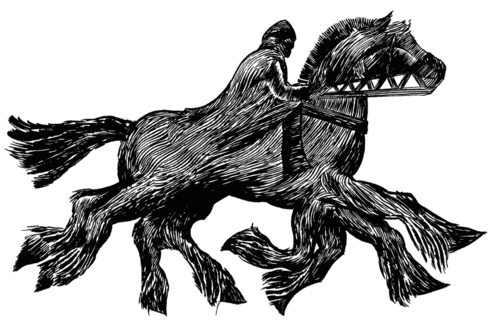Sleipnir (sleɪp nər)
Basic Information
Anatomy
Sleipnir are the native horse species of the Montius continent. Their most prominent deviation from standard horses is the fact that they have three pairs of legs as opposed to the usual two. The additional pair of legs is located behind the first set, giving Sleipnir a broad chest and shoulder area. These horses are sturdier than horses from the mainland. They are built for trudging through snow and over the unforgiving tundra terrains. Sleipnir are shorter than most horses, standing a little bit taller than ponies. Most of their muscular power is concentrated in the front shoulders and legs, meaning they are comparatively slow but are able to withstand the elements of their home terrain more easily.
These horses are also omnivores and have developed sharp canines to assist in tearing meat before consumption. Their skulls are not as elongated as an average farm horse and are typically rounder as well. Their skeletons are dense and their leg bones in particular are not as prone to breaking. Their digestive systems are more complex than a typical horse's as well, as sleipnir digest meat on top of grasses. Due to the scarcity of food available in the north, they are also scavengers, and will consume meat off dead carcasses they come across. Their digestive system is more prepared to process meat that is occasionally already decaying without poisoning the sleipnir.
Ecology and Habitats
Sleipnir have adapted for a tundra and arctic environment. Their six legs allow them to push through snow and rocky terrain without as much chance of breaking a leg or becoming exhausted. Their heat vision helps to find food, water, and shelter when the sun does not rise for half the year. They have adapted to consume meat as well as plant matter, which gives them a better chance of finding enough food in the snowy northern climates. Their fur and manes are long and shaggy, with hollow follicles over black skin to help retain heat. Their coloring ranges from dark dappled grey to pure white to blend in to their surroundings, with lighter patterns being more common the further north the sleipnir's ancestry comes from.
Dietary Needs and Habits
Wild sleipnir spend the majority of their time foraging for grasses and insects as their main forms of sustenance. During the summer cycles, they build up large fat stores from the more readily available food, which are then typically depleted in the winter cycles. While all sleipnir eat grasses, southern sleipnir have been known to kill small fish in streams by crushing them with their hooves and sucking the meat off the bones. Northern wild sleipnir have also been observed trampling small mammals such as rabbits when possible. All sleipnir are scavengers as well and will not turn their noses up to cleaning up the remnants of larger dead animals, up to and including other sleipnir. Herds of wild sleipnir roam Montius instead of settling in one specific place, so they do not store their food in any one specific location. The stronger members of the herds will chase away any encroaching scavengers or predators while the younger and weaker sleipnir eat first. Their typical method of protection usually involves trampling or crushing with their powerful legs, although they will also snap at smaller animals with their teeth in a pinch.
Additional Information
Perception and Sensory Capabilities
Sleipnir are extraordinarily perceptive, with their hearing and sight elevated above that of a typical horse. These horses have adapted to the long dark winter months by developing exceptional heat vision and tremor senses that allows them to spot predators and prey against the rocks and snow in the dark.
Remove these ads. Join the Worldbuilders Guild




Comments